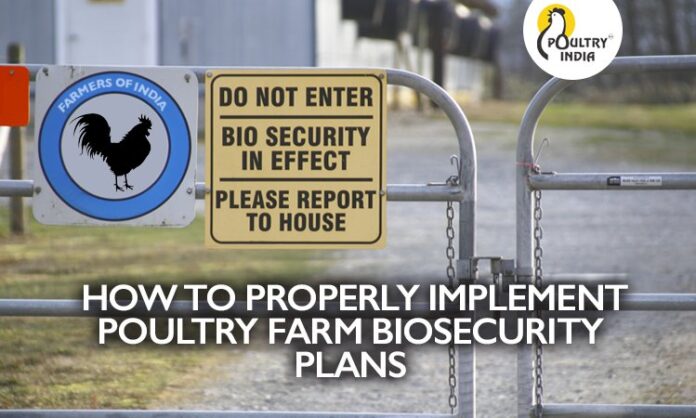Biosecurity on Poultry Farms in India
The India poultry market size reached INR 1,905.3 Billion in 2022. Looking forward, Pashudhan Praharee Team expects the market to reach INR 3,477.8 Billion by 2028, exhibiting a growth rate (CAGR) of 10.18% during 2023-2028. The expanding population across the country, increasing demand for poultry products, changing consumer dietary preferences, rising disposable incomes, and rapid growth in the food service sector are among the key factors driving the market growth. and it is expected to reach INR 4,340 billion by 2024. Notable for its production of eggs, meat and employing rural people, poultry farming in India is growing every year. However, with the tremendous growth, the incidences of infectious disease outbreaks in poultry farms have also increased across different regions. To counter the challenge, biosecurity on poultry farms has received increased interest, especially over the past few decades.
What is Biosecurity?
Biosecurity refers to the procedures or methods used to prevent the spread and introduction of disease-causing organisms in poultry farms. Infectious agents like parasite, fungi, protozoa, viruses and bacteria are a serious threat to poultry health which in turn leads to morbidity and mortality. Biosecurity aims to overcome the indirect and direct threat of diseases to poultry through effective control measures like cleaning, disinfection, traffic control and segregation.
Its main objectives are:
• Keep out highly contagious diseases like Newcastle Disease (RD), Infectious Bronchitis (IB), Gumboro Disease (IBD), etc.
• Reduce pathogens like Salmonella and E. coli, etc
• Control vector habitat and attractants
• Sanitisation of equipment and supplies
• Improve the health of the flock
• Reduce mortality losses
• Increase profitability
Why Biosecurity is a Decisive Factor for the Indian Poultry Industry?
Despite being one of the largest producers of broiler meat and eggs, the Indian poultry industry is faced by some major challenges. The majority of Indian poultry farms are open buildings where climate control and quarantine mechanisms are out of place. This exposes the birds to potential epidemics and diseases. A study conducted on the samples collected from 160 chickens received at Veterinary University Disease Diagnostic Laboratory (VUDDL) in Tamil Nadu from 2014 to 2016 showed the rapid prevalence of infectious diseases like Newcastle Disease, E. Coli infection, Klebsiella spp infection, Salmonellosis, Fowl Cholera, Clostridia infection and Candida infection. The domestic poultry market in India lacks comprehensive quality standards to maintain optimal hygiene in poultry farms. Farm licensing is done at the municipality level where people often lack the expertise, knowledge and human resources to adhere to the quality standards. Lack of clean and hygienic dry processing facilities along with waste treatment plants can lead to serious environmental concerns. The wet processing machineries can be a serious threat to the environment owing to poor waste disposal management. On top of that, the intensive poultry farming practises are restricting the birds to immunologically compromised, unhygienic crowded locations that are leading to zoonotic disease outbreaks. To combat the zoonotic diseases, there is indiscriminate use of antibiotics which is leading to bacteria developing resistance against them. The fight against these challenges requires extensive biosecurity measures at every step of poultry farming to mitigate the threats and remain profitable.
The Rising Concern of Zoonotic Diseases
Intensive poultry farming practises across the country leading to skin lesions, painful lameness, bone problems, lung problems, breathing difficulties and skin lesions in chickens. A huge percentage of chickens raised through poultry farming in India spend their entire lives in poorly lit, barren and cramped spaces. All these factors lead to the evolution of different zoonotic diseases. The infected birds are further spreading the infection to other flocks, and even to humans, through consumption of eggs and meat. The indiscriminate use of antibiotics to keep a check on the diseases and to help the birds gain weight faster are further adding to the woes. The use of antibiotics is accelerating the development of antibiotic resistance in the pathogens that can lead to treatment failures, transmission to humans and economic losses. When it comes to meat and egg consumption, food safety has become a serious concern among consumers. To understand the perception of consumers regarding chicken’s reared for food, World Animal Protection carried out a survey that covered different countries like Indonesia, India and Thailand in south-east Asia. In the survey, it was found out that 9 out of 10 consumers had concerns about chicken farming and 1 in every 5 consumers had concerns about chicken gut health, how the chickens were raised and where the meat came from.
The Way Forward
In poultry production, biosecurity acts as a fundamental component. Negligence to biosecurity measures will result in huge losses to the poultry industry in India as it acts as a barrier against perpetuation, penetration and infection. Biosecurity standards need to be developed and upgraded. Apart from that, there is an urgent need for research tie-ups with various institutions concerning production, processing and marketing of poultry products. Farmers also need to be educated about biosecurity needs through awareness programs. To suppress the use of antibiotics that is resulting in the development of superbugs, bacteriophage therapy is an alternative solution which can be adopted by poultry farmers. Bacteriophages are beneficial viruses or “bacteria eaters” that can infect and kill targeted pathogenic bacteria without causing any damage to the chickens and even humans.
Compiled & Shared by- Team, LITD (Livestock Institute of Training & Development)
Image-Courtesy-Google
Reference-On Request.


